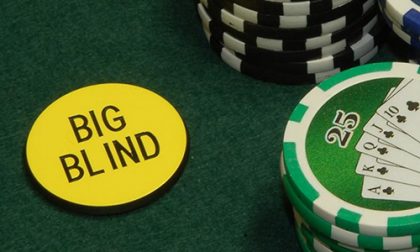Playing the Big Blind Ante: Mostly Positive, Some Negative
If you haven’t been watching the live-tournament scene in recent months, you might not be aware of the latest innovation that’s slowly spreading ‘cross the land: Big Blind Ante tournaments. For those unfamiliar with the concept, it’s an innovation designed to speed up the pace of play in a tourney once said tourney has reached the anteing stage, requiring the big blind to also post the collective antes for each of the players at the table, rather than making those players put those individual antes forward each and every hand.
The concept has a lot of positives. It speeds up the pace of play in several different ways, saving the time spent in waiting for each player to post the required ante, saving the dealer a few seconds each hand in having to scoop up those antes, and it also saves a lot of time in making chip change at the table, since all the anteing chips invariably wind up in just two or three stacks.
 It also gets rid of the lowest-denomination chips much sooner, thus cleaning up a lot of table clutter, and that’s a time saver, too. If you’re playing in one of these things, with a level time of, say, 30 minutes per level, you’ll gain a couple of extra hands of action per level. It makes that much of a difference. All those handfuls of seconds add up fast.
It also gets rid of the lowest-denomination chips much sooner, thus cleaning up a lot of table clutter, and that’s a time saver, too. If you’re playing in one of these things, with a level time of, say, 30 minutes per level, you’ll gain a couple of extra hands of action per level. It makes that much of a difference. All those handfuls of seconds add up fast.
I played my first big-blind-ante tourney at the Rio this summer, in one of the late-night “Daily Deepstacks” offerings. Having done so, I understand why these tourneys are spreading at a relatively fast rate. I also expect that the innovation will gain widespread approval on the lower-profile poker scene, meaning home and private games, charity-themed tournaments, all sorts of poker offerings with small buy-ins and lesser operational overhead. It simply makes for a cleaner, easy-to-run game, and that will be an important thing.
It won’t ever prevent a dealer from having to remind perpetually ignorant or preoccupied players that it’s their turn to ante, as I’ve witnessed, and it may actually encourage that behavior a little bit. Then again, from the dealer’s and other players’ perspective, it’s still better to have to wait on some ignoranus (spelling intentional) just once or twice a round, rather than every damned hand.
If there’s one problem that the big-blind-ante format is likely to have, it’s that it’s likely to cause an increase in table-transfering players taking their good-natured (and rules-breaking) time in moving from a broken table to a new seat, in the hope of dodging the next big blind and posting of collective antes. Those antes are usually as much as the big blind itself, so it’s a doubled incentive for the petty cheats among us to dawdle.
That little bit of petty cheating, regarding players finding ways to dodge coming into a new table and seat in time to post the big blind, has been a minor debating point among various poker players’ social media accounts in recent weeks. Call it cheating, call it an angle shot aimed at the tournament in general; it is what it is. Under a big-blind-ante format, for its other benefits, that ethically-saggy behavior will increase.
It will also increase in direct proportion to the size of the event itself. In an event with just a few tables, it’s not much of an issue at all. But when one talks about major tourney venues, such as the Rio in Vegas or Aria (where the concept was first introduced), or at WPT events such as at Commerce in Los Angeles, it becomes at least a topic of controversy. Even though big-blind-ante formats offer real time- and labor-saving benefits, it’s not unimaginable to see table-change abuse increase to the point where some players have to be forcibly walked to their new seats — a real pain in the ass for tournament directors that have far better things to do.
It’ll be interesting to see how this develops over the next few years. I believe the big-blind-ante format is here to stay, though it’s not clear that all the possible wrinkles have been ironed out.




















COMMENTS